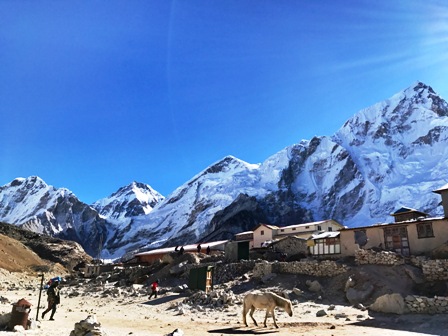One World Trekking has been trekking in Nepal and organizing treks to Everest Base Camp since 1988. Many things have changed in Nepal and for the trekking industry over the past 31 years, but one thing has remained the same…the look of amazement on our customer’s faces as they gaze up at the highest mountains on Earth.

Can I do it?
Any reasonably fit and prepared person can reach Everest Base Camp and with just a little extra physical training. Over the years we have safely guided people of all shapes, sizes, ages and physical abilities to the 17,500-foot Base Camp and even to the top of the viewpoint peak known as Kala Pattar at 18,200 feet.
By flying to the Lukla Airport at 9,200 feet in the Khumbu, we have developed a time tested itinerary to allow for the need to acclimatize gradually to the altitude. It takes 9 days for our groups to hike (no climbing and nothing technical is involved) the 30 miles from Lukla to Everest Base Camp. With acclimatization days scheduled in the Sherpa capital of Namche Bazaar and at the quaint hamlet of Dingboche, the average distance we walk each day is approximately 5 miles. The majority of our hiking route is on well-maintained trails while only the last few miles to Everest Base Camp itself are on the rubble of the glacial moraine.
With the added bonus of staying in relatively comfortable lodge accommodations along the entire route, a successful hike to Everest Base Camp is open to and within reach of any active person with the desire to get up close to Mount Everest.
Is it safe?
Despite all the books, movies and news articles depicting climbers in hair-raising and life-threatening situations, the trek to Everest Base Camp is a straight-forward hiking adventure. Our groups are escorted in Kathmandu and fully-supported on the trek by our team of experienced, English-speaking Nepali guides. The route to and from Everest Base Camp is serviced by 3G cellular communications and all of our guides carry cell phones and are in 24/7 contact with the main office in Kathmandu as well as our office in Colorado. In addition, the Everest region has staffed medical facilities specializing in treatment of trekkers’ illnesses and provides helicopter medical evacuations if needed.
Is it fun?
Of course it is! This is why the trek to Everest Base Camp is arguably the most famous, popular and beautiful hiking adventure in the world! Trekking to Everest is an almost spiritual experience; hiking along village trails, passing colorful prayer flags and centuries old monasteries.
The Khumbu region on the south side of Mount Everest is the traditional home of the Sherpa people. Surrounded by spectacular peaks, it is a justifiably popular destination for mountain hiking. Since the first Westerners visited this area, mountaineers and trekkers from all walks of life travel halfway across the world just to get a glimpse of the Mount Everest.
When should I go?
The months outside of the summer monsoon season offer the best conditions for trekking. Pre-monsoon, from late March through May, is the main climbing season for Everest and at this time there will be many expeditions at the base camp. This is the time to go if you want to get the feel of the climbing season on the world’s highest peak. The post-monsoon months of late September through November usually offer the clearest skies and the most settled weather before the onset of winter. Fewer people trek in the winter months between December and February, but visiting the Khumbu and Everest Base Camp (despite the cold and likelihood of encountering snow) during this time can be a magical experience.
